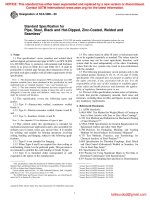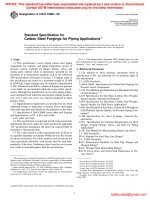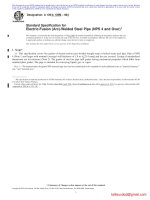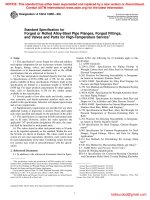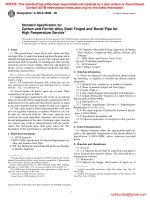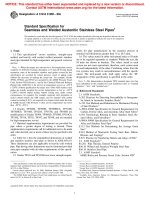Astm e 1083 00 (2017)
Bạn đang xem bản rút gọn của tài liệu. Xem và tải ngay bản đầy đủ của tài liệu tại đây (126.91 KB, 4 trang )
This international standard was developed in accordance with internationally recognized principles on standardization established in the Decision on Principles for the
Development of International Standards, Guides and Recommendations issued by the World Trade Organization Technical Barriers to Trade (TBT) Committee.
Designation: E1083 − 00 (Reapproved 2017)
Standard Test Method for
Sensory Evaluation of Red Pepper Heat1
This standard is issued under the fixed designation E1083; the number immediately following the designation indicates the year of
original adoption or, in the case of revision, the year of last revision. A number in parentheses indicates the year of last reapproval. A
superscript epsilon (´) indicates an editorial change since the last revision or reapproval.
to see a ground red pepper stronger than this. But in the event
that a pepper with more than 70 000 SHU is tested, there
remains the last 2 cm on the line scale.
3.1.2 moderate heat—N-vanillyl-n-nonamide, 0.80 ppm.
This is a “moderate” amount of pepper heat. On the line scale,
10 cm.
3.1.3 rinse—to purge the oral cavity with unsalted soda
crackers and water by slowly chewing and swallowing the
cracker, followed by swirling the water around in the mouth
and swallowing. This procedure is repeated as often as is
natural and comfortable for the panelist.
3.1.4 scoville heat units (SHU)—the commonly accepted
unit for expressing heat levels in capsicum products (see 2.1
and 2.2). Scoville heat units range from 0 to 1 500 000.
3.1.5 slight heat—N-vanillyl-n-nonamide, 0.40 ppm. This is
a “slight” amount of pepper heat. On the line scale, 5 cm.
3.1.6 stock solution—a standardized solution of 6.0 ppm of
N-vanillyl-n-nonamide that is used to prepare other dilutions of
N-vanillyl-n-nonamide (see 10.1.2).
3.1.7 strong heat—best defined by concept. Hotter than the
1.30 ppm N-vanillyl-n-nonamide sample. On the line scale, 15
cm.
3.1.8 threshold heat—best defined by concept rather than by
a standard dilution of N-vanillyl-n-nonamide. Threshold is that
point where a panelist just barely senses burn/heat. On the line
scale, 1.25 cm.
3.1.9 zero heat—N-vanillyl-n-nonamide, 0 ppm. No sensory
heat. On the line scale, 0 cm.
1. Scope
1.1 This test method describes standardized procedures for
the sensory evaluation of heat in ground red pepper2 ranging
from 10 000 to 70 000 scoville heat units.
1.2 This test method is intended as an alternative to the
Scoville Heat Test, but results can be expressed in scoville heat
units (SHU).
1.3 This test method does not apply for oleoresin
capsicums, low-heat chili peppers, or chili powder.
1.4 The values stated in SI units are to be regarded as
standard. No other units of measurement are included in this
standard.
1.5 This standard does not purport to address all of the
safety concerns, if any, associated with its use. It is the
responsibility of the user of this standard to establish appropriate safety and health practices and determine the applicability of regulatory limitations prior to use. Specific hazards
statements are given in Section 8.
2. Referenced Documents
2.1 ASTM Publication:3
STP 434 Manual on Sensory Testing Methods
2.2 ISO Standard:4
3513-1977(E) Spices and Condiments—Chilies—
Determination of Scoville Index
3. Terminology
3.1 Definitions of Terms Specific to This Standard:
3.1.1 approaching strong heat—N-vanillyl-n-nonamide,
1.30 ppm. This is 13.0 cm on the 15-cm line scale. It is unusual
4. Summary of Test Method
4.1 Ground red pepper is steeped in hot water with
polysorbate-80 for 20 min, filtered, and the filtrate diluted in
room temperature water. Trained panelists compare the heat in
the pepper extract to a known concentration of a standard
solution of synthetic capsaicin (N-vanillyl-n-nonamide) using a
15-cm line scale. The tasting procedure is timed and takes 2
min for one test sample and 9 min for 2 test samples.5
1
This test method is under the jurisdiction of ASTM Committee E18 on Sensory
Evaluation and is the direct responsibility of Subcommittee E18.06 on Food and
Beverage Evaluation.
Current edition approved Feb. 1, 2017. Published February 2017. Originally
approved in 1986. Last previous edition approved in 2011 as E1083 – 00 (2011).
DOI: 10.1520/E1083-00R17.
2
Available from the American Spice Trade Association, 580 Sylvan Ave.,
Englewood Cliffs, NJ 07632.
3
Available from ASTM International Headquarters, 100 Barr Harbor Drive, PO
Box C700, West Conshohocken, PA 19428–2959.
4
Available from International Organization for Standardization (ISO), 1, ch. de
la Voie-Creuse, Case postale 56, CH-1211, Geneva 20, Switzerland, http://
www.iso.ch.
5
Gillette, M. H., Appel, C. E., Lego, M. “A New Method for the Sensory
Evaluation of Red Pepper Heat,” Journal of Food Science, Vol. 49, No. 4, 1984, p
1028.
Copyright © ASTM International, 100 Barr Harbor Drive, PO Box C700, West Conshohocken, PA 19428-2959. United States
1
E1083 − 00 (2017)
9.3.1 N-vanillyl-n-nonamide (0 ppm)—Add none of the
stock solution to 200 mL of water.
9.3.2 N-vanillyl-n-nonamide (0.40 ppm)—Dilute 13.4 g of
stock solution to 200 mL with water.
9.3.3 N-vanillyl-n-nonamide (0.80 ppm)—Dilute 26.8 g of
the stock solution to 200 mL with water.
9.3.4 N-vanillyl-n-nonamide (1.30 ppm)—Dilute 43.3 g of
the stock solution to 200 mL with water.
4.2 Panelists are screened for their accuracy and precision
and trained to use the 15-cm line scale during two to three
15-min training sessions.
4.3 Standard general requirements for sensory testing are
followed in accordance with ASTM STP 434.
5. Significance and Use
5.1 This test provides quick and accurate ratings for the
sensory heat in ground red peppers ranging from 10 000 to
70 000 scoville heat units.
9.4 Session I (15 min)—Brief the randomly selected panelists on the purpose of this test method. The purpose of the first
session is to standardize their tongues and mouth to the
reference standards with respect to the 15-cm line scale on the
ballot (Appendix X1). Explain to the panelists that they may
use any of the infinite number of points on the line scale to
describe how hot a given sample is. Panelists will taste (see
10.2.3.1 – 10.2.3.3) the coded standard dilutions you prepared,
evaluate them critically, concentrating and memorizing their
individual sensory heat levels. Panelists rinse well between
samples with crackers and water for 2 min (they are timed).
After the standards have been tasted, the correct rating for each
reference standard is given. Definitions for “0,” “threshold,”
“slight,” “moderate,” “approaching strong,” and “strong” are
provided. Refer to 3.1.4 – 3.1.8.
5.2 Sensory results from this test method correlate highly
(r = 0.94) with results from high pressure liquid chromatography; making the two methods substitutable.6
6. Apparatus
6.1 Two Magnetic Hot Plate Stirrers.
6.2 Four beakers, 400 mL.
6.3 One Small Beaker, (50 to 100 mL).
6.4 One Analytical Balance (sensitive to 0.00 g).
6.5 Two Volumetric Flasks, stoppered, 1000 mL.
6.6 One Stopwatch.
9.5 Session II (15 min)—This session should follow the first
training session by one to two days. During this session, the
panelists will be both trained and tested. Explain to the
panelists how they will be evaluating the actual red pepper test
samples. Explain the entire tasting procedure as defined below:
9.5.1 Panelists are served 10-mL portions of each of 2
samples in coded medicine cups. The control (0.4 ppm
N-vanillyl-n-nonamide) is always served first, coded “C.” The
test sample is served second, with a random 3-digit code. Two
sets of samples are evaluated per sitting. The tasting procedure
is described under 10.2.3.
9.5.2 For this second training session, the panelists are
served the “control” first, coded “C,” then a test sample coded
with a random 3 digit code. They will evaluate two sets of
samples:
9.5.2.1 Control and 0.80 ppm N-vanillyl-n-nonamide.
9.5.2.2 Control and 0.40 ppm N-vanillyl-n-nonamide (the
same as the control).
9.5.2.3 Do not tell the panelists what the test samples are.
After learning the standard heat intensities during Session 1,
they theoretically should rate the 0.80-ppm sample at “moderate” and the 0.40-ppm sample at “slight” on the line scale. A
2-cm variation from the desired response is acceptable. The
panel, as a whole, should also be within 2 cm of the desired
response. If not, another training session must be conducted.
After the session, advise the panelists about the sample
identities and the expected ratings for them. Drop any panelists
that cannot reproduce their judgement within 2 cm after the
third training session. You should have a minimum of five
panelists pass for the formal testing.
7. Reagents and Materials
7.1 Coffee-Type or Low Flavor Qualitative Filter Paper.
7.2 Medicine Cups.
7.3 Unsalted Soda Crackers.
7.4 Bottled Distilled or Deionized Water when available, or
still spring water.
7.5 Polysorbate-80 (Food Grade).
7.6 Rating Forms (15-cm line scale anchored at 0 (none),
1.25 cm (threshold), 5 cm (slight), 10 cm (moderate), 15 cm
(strong); see Appendix X1.
7.7 N-vanillyl-n-nonamide, available from Penta International.
8. Hazards
8.1 Pure N-vanillyl-n-nonamide will burn the eyes and skin
upon direct contact. Gloves and caution must be used when
handling N-vanillyl-n-nonamide in the crystalline form.
9. Calibration and Standardization of Panelists
9.1 Select, at random, 10 to 12 panelists. Selection should
be based upon availability, attitude, and motivation of panelists. Screening for taste sensitivity is not necessary.
9.2 Prepare stock solution of N-vanillyl-n-nonamide (see
10.1.2).
9.3 Dilute the stock solution of N-vanillyl-n-nonamide to
the following concentrations:
10. Procedure
10.1 Sample Preparation:
10.1.1 Evaluate two samples per test: (1) a known control
(0.40 ppm dilution of N-vanillyl-n-nonamide) prepared from
6
Hoffman, P. F., Salb, M. C., and Galetto, W. G. “Separation and Quantitation of
Red Pepper Heat Principles by Reverse Phase HPLC,” Journal of Agricultural Food
Chemistry, Vol. 31, No. 6, Oct. 1983, p 1326.
2
E1083 − 00 (2017)
10.2.3.5 Rinse intermittently with unsalted soda cracker and
20°C spring water during a 60-s interval (timed).
10.2.3.6 Rinse with 20°C spring water immediately prior to
second sample.
10.2.3.7 Take entire second sample (test sample) in mouth,
hold for about 5 s, swallow slowly.
10.2.3.8 Wait 30 s (timed).
10.2.3.9 Rate second sample.
10.2.3.10 Panel dismissed if only one test sample is to be
evaluated. If two test samples are to be evaluated:
10.2.3.11 Wait 5.0 min (timed). Rinse well with water and
crackers during this time.
10.2.3.12 Repeat 10.2.3.1 – 10.2.3.9 for the second set of
samples.
10.2.4 Note that the control is rated before each test sample.
the stock solution; and (2) the unknown ground red pepper.
Preparation of the two samples is as follows:
10.1.2 Prepare the “stock” solution of N-vanillyl-nnonamide by diluting 6.0 ppm N-vanillyl-n-nonamide and 200
ppm polysorbate-80 in spring or distilled water. Keep this
solution stoppered and refrigerated for the duration of the test
series. It will remain stable for 2 to 3 weeks. Check regularly
for precipitation of N-vanillyl-n-nonamide. To make the stock
solution, weigh 0.60 g of N-vanillyl-n-nonamide and 20 g of
polysorbate-80 into a small beaker (50 mL). Heat the mixture
on a hot plate (low setting) for a minimum of 10 min to
dissolve N-vanillyl-n-nonamide. Quantitatively transfer the
heated mixture into a 1-L volumetric flask using hot (about
70°C) spring or distilled water. Cool to room temperature.
Dilute the transferred solution to 1 L using room temperature
(20°C) spring or distilled water. Dilute 10 g of this solution to
1 L in a second 1-L volumetric flask. Stopper and refrigerate.
Final concentrations equal 6 ppm N-vanillyl-n-nonamide, 200
ppm polysorbate-80. This is the stock solution.
10.1.3 For each test, dilute the stock solution of N-vanillyln-nonamide to 0.40 ppm N-vanillyl-n-nonamide and 13.3-ppm
polysorbate-80 in 20°C spring or distilled water by diluting
13.4 g of the stock solution to 200 mL with room temperature
water. Refer to this diluted solution as the control for each test.
10.1.4 Red Pepper Samples—On the day of the test, combine and dilute 0.25 g of the pepper sample and 0.02 g of
polysorbate-80 to 100 g with 75°C spring or distilled water and
place the preheated (4 min on high heat) hot plate stirrer on
medium stir speed. Set the hot plate stirrer on high heat for 1.5
min, then on medium heat for 20 min of simmering (90°C) and
stirring. Filter the extracted pepper using coffee or qualitative
filter papers. Dilute 10 g of the filtrate to 200 g using 20°C
spring or distilled water. Final concentration of the extracted
and diluted solution is 125-ppm pepper and 10-ppm
polysorbate-80.
11. Calculation and Interpretation of Results
11.1 Sensory heat ratings are obtained by measuring the
distance (in centimetres to the first decimal place) from the left
hand side of the scale (0) to the mark placed on the ballot for
each sample. Values range from 0.0 to 15.0, as the scale is 15
cm long.
11.2 Individual panelist ratings are averaged to generate a
panel mean.
11.3 Sensory heat ratings can be converted into scoville heat
units by using Fig. 1, or the equation: Sensory Heat Ratings = 0.199 (calculated scoville × 10−3) − 0.223.
12. Precision and Bias
12.1 Precision:
12.1.1 Within-laboratory (repeatability) and betweenlaboratory (reproducibility) standard deviations are 2.0 cm or
less on the 15-cm line scale.
12.1.2 Precision data were derived from results of a collaborative test involving 14 laboratories.
10.2 Sample Presentation:
10.2.1 A round or conference table is preferred: use booths
only if all panelists are able to be “monitored” by the panel
leader. Conduct the test using all 5 to 10 trained panelists
simultaneously as the process is timed by the panel leader (if a
panelist misses a panel, he/she must also be timed during
his/her make-up test).
10.2.2 Serve panelists 10-mL portions of each sample in
coded medicine cups. Always serve the control first, coded
“C.” Serve the test sample second, with a random 3-digit code.
Evaluate two sets of samples (control and test sample) per
sitting. A 15-cm line scale anchored at 0 cm (0 heat), 1.25 cm
(threshold heat), 5.0 cm (slight heat), 10.0 cm (moderate heat),
and 15 cm (strong heat) is used (Appendix X1.). A separate
scale is used for each set of samples.
10.2.3 The tasting procedure is as follows:
10.2.3.1 Rinse before first sample (control) with unsalted
soda cracker and 20°C spring or distilled water.
10.2.3.2 Take entire first sample (control) in mouth, hold for
about 5 s, swallow slowly.
10.2.3.3 Wait 30 s (timed).
10.2.3.4 Rate first sample at “slight” on ballot.
FIG. 1 Linear Relationship Between HPLC-Determined Scoville
Heat Units and Sensory Heat Ratings
3
E1083 − 00 (2017)
12.2 Bias—This test method corrects for psychological bias
by coding of the test samples, use of an internal reference
(control) for each test, by training of the panelists, and by timed
rinsing between samples.
APPENDIX
(Nonmandatory Information)
X1. SENSORY HEAT RATING BALLOT
ASTM International takes no position respecting the validity of any patent rights asserted in connection with any item mentioned
in this standard. Users of this standard are expressly advised that determination of the validity of any such patent rights, and the risk
of infringement of such rights, are entirely their own responsibility.
This standard is subject to revision at any time by the responsible technical committee and must be reviewed every five years and
if not revised, either reapproved or withdrawn. Your comments are invited either for revision of this standard or for additional standards
and should be addressed to ASTM International Headquarters. Your comments will receive careful consideration at a meeting of the
responsible technical committee, which you may attend. If you feel that your comments have not received a fair hearing you should
make your views known to the ASTM Committee on Standards, at the address shown below.
This standard is copyrighted by ASTM International, 100 Barr Harbor Drive, PO Box C700, West Conshohocken, PA 19428-2959,
United States. Individual reprints (single or multiple copies) of this standard may be obtained by contacting ASTM at the above
address or at 610-832-9585 (phone), 610-832-9555 (fax), or (e-mail); or through the ASTM website
(www.astm.org). Permission rights to photocopy the standard may also be secured from the Copyright Clearance Center, 222
Rosewood Drive, Danvers, MA 01923, Tel: (978) 646-2600; />
4

